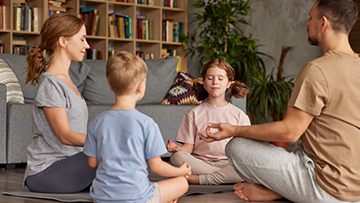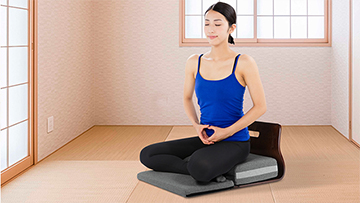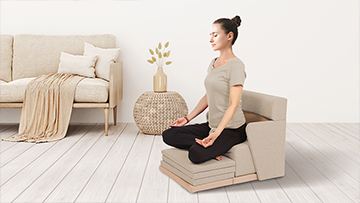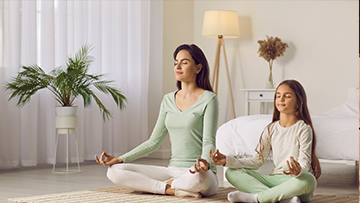Comparing Meditation Postures
Which Meditation Postures Suits You Best?
Meditation is a practice that brings numerous benefits, from enhancing mental clarity to promoting overall well-being. One of the key aspects of a successful meditation practice is finding the right posture that suits your body and needs. Different meditation postures offer various advantages and can accommodate different physical conditions and personal preferences. In this article, we will compare several common meditation postures to help you determine which one suits you best.
Cross-Legged Position (Sukhasana)
The cross-legged position, also known as Sukhasana or "easy pose," is one of the most popular meditation postures. This position involves sitting on the floor with your legs crossed and your back straight.Benefits:
- Grounding and Stability: This posture helps create a sense of grounding and stability, making it easier to maintain focus during meditation.
- Accessible for Most People: It is relatively easy to perform and does not require a high level of flexibility.
- Supports Natural Spine Alignment: Sitting cross-legged helps maintain the natural curve of the spine, promoting better posture and reducing strain on the back.

Considerations:
- Some individuals may find it challenging to sit cross-legged for extended periods, especially if they have tight hips or knee issues.
- Using a cushion to elevate the hips above the knees can enhance comfort and alignment.
Kneeling Position (Seiza)
The kneeling position, or Seiza, involves sitting on your shins with your knees bent and your buttocks resting on your heels or a cushion.Benefits:
- Enhanced Alertness: This posture keeps the spine straight and the body alert, which can help prevent drowsiness during meditation.
- Reduces Back Strain: By distributing weight more evenly, Seiza can alleviate pressure on the lower back.
- Suitable for Long Meditations: Many practitioners find this position comfortable for extended meditation sessions.
Considerations:
- Kneeling can be uncomfortable for individuals with knee or ankle problems.
- Using a cushion or meditation bench can help reduce discomfort and support proper alignment.
Chair Sitting
Sitting in a chair is a practical and comfortable meditation posture, especially for those who have difficulty sitting on the floor.
Benefits:
- Accessibility: This posture is accessible to almost everyone, regardless of physical condition or flexibility.
- Support for Back and Legs: Sitting in a chair with proper back support can reduce strain on the back and legs.
- Versatility: Chairs can be used anywhere, making it easy to meditate at home, in the office, or while traveling.
Considerations:
- Ensure the feet are flat on the floor, and the knees are at a 90-degree angle to maintain proper alignment.
- Use a cushion or rolled-up towel for additional lumbar support if needed.
Lying Down (Savasana)
Lying down in the Savasana posture, also known as the corpse pose, is a relaxing way to meditate, especially for guided meditations or body scans.
Benefits:
- Deep Relaxation: This posture promotes deep relaxation and is particularly effective for stress relief and guided meditations.
- No Strain on Joints: Lying down eliminates pressure on the joints, making it ideal for those with joint pain or injuries.
- Ease of Practice: It requires minimal effort, making it accessible to everyone.
Considerations:
- It can be easy to fall asleep in this position, so it may not be suitable for all types of meditation.
- Use cushions under the head, neck, and knees to maintain alignment and comfort.
Lotus Position (Padmasana)
The lotus position, or Padmasana, involves sitting with each foot placed on the opposite thigh. It is a traditional and highly stable posture used in many meditation practices.
Benefits:
- Deep Stability: This posture provides a very stable base, which can enhance concentration and deepen the meditation experience.
- Promotes Flexibility: Regular practice can increase hip and knee flexibility.
- Symbolic Significance: The lotus position is often associated with spiritual growth and enlightenment.
Considerations:
- It requires a high level of flexibility and may not be suitable for beginners or individuals with hip or knee issues.
- Practitioners should ease into this posture gradually to avoid injury.
Half Lotus Position (Ardha Padmasana)
The half lotus position is a simpler variation of the full lotus, where one foot is placed on the opposite thigh, and the other foot is tucked under the opposite thigh.
Benefits:
- Enhanced Stability: Provides a stable base for meditation similar to the full lotus but with less strain.
- Improved Flexibility: Helps improve flexibility in the hips and knees over time.
- Easier Transition: A good intermediate step towards achieving the full lotus position.
Considerations:
- May still be challenging for those with limited flexibility in the hips and knees.
- Using a cushion can help elevate the hips and improve comfort.
Burmese Position (Sukhasana Variation)
The Burmese position is similar to the cross-legged position but with both feet resting on the floor in front of each other, rather than crossing the legs.Benefits:
- Comfortable for Beginners: Easier on the knees and hips compared to the full or half lotus positions.
- Good for Longer Sessions: Allows for prolonged sitting with minimal discomfort.
- Natural Alignment: Encourages a natural curve in the spine and helps maintain proper posture.
Considerations:
- Elevating the hips with a cushion can enhance comfort and alignment.
- Not as stable as the lotus positions but more accessible.
Standing Meditation (Zhan Zhuang)
Standing meditation, or Zhan Zhuang, is a practice from Chinese martial arts and Qigong that involves standing still in a relaxed, upright posture.Benefits:
- Strengthens Legs and Core: Builds strength and endurance in the legs and core muscles.
- Promotes Energy Flow: Encourages the free flow of energy (Qi) through the body.
- Improves Posture and Balance: Enhances overall posture and balance.
Considerations:
- May be challenging for beginners or those with weak leg muscles.
- Requires a calm environment to maintain focus without distractions.
Walking Meditation (Kinhin)
Walking meditation, or Kinhin, involves mindful walking, focusing on the movement of the feet and the breath.Benefits:
- Dynamic Practice: Provides a break from static sitting postures and introduces movement.
- Enhances Mindfulness: Encourages mindfulness of the body in motion and the environment.
- Accessible to All: Suitable for people of all ages and physical conditions.
Considerations:
- Requires space to walk uninterrupted.
- Should be practiced slowly to maintain mindfulness and focus.
Reclining Position (Reclined Bound Angle Pose)
This posture involves lying on your back with the soles of your feet together and knees falling open to the sides, supported by cushions.Benefits:
- Deep Relaxation: Promotes deep relaxation and stress relief.
- Opens Hips: Gently stretches and opens the hips.
- Supports Restorative Practices: Ideal for restorative meditation and guided relaxation.
Considerations:
- May not be suitable for all types of meditation, especially those requiring alertness.
- Use plenty of cushions to support the knees and back for comfort.
Meditation postures are highly personal :

Meditation postures are highly personal, and the best one for you depends on your body’s needs and your meditation goals. Whether you choose the cross-legged position, kneeling, chair sitting, lying down, lotus, half lotus, Burmese, standing, walking, or reclining position, each offers unique benefits and can accommodate different physical conditions and preferences. Experiment with various postures to discover which one helps you achieve the most comfortable and effective meditation practice. The key is to find a posture that allows you to remain comfortable and focused, facilitating a deeper connection with your inner self.